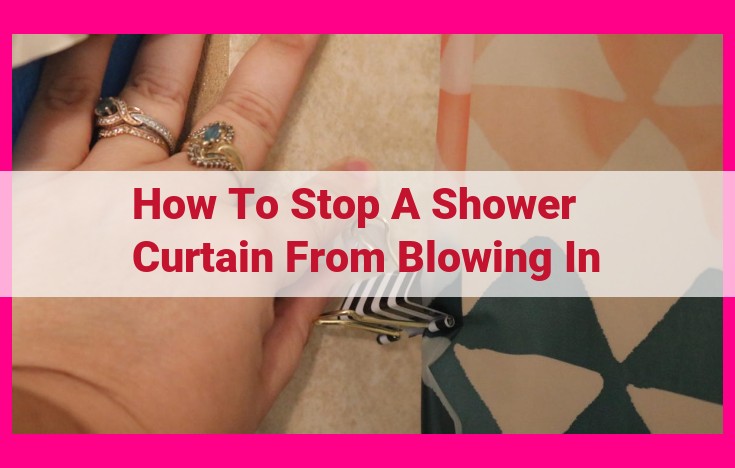Prevent Shower Curtain Blowouts: Expert Solutions For A Watertight Seal

To prevent shower curtains from blowing in, secure them with weights, suction cups, or adhesive/magnetic strips. Shower curtain tension rods provide additional support. Maintain them by leaving the curtain outside the tub when showering and tucking excess under the liner. Use the rod, curtain, and securing mechanisms together to create a watertight seal, minimizing movement from water pressure.
Essential Shower Curtain Components: The Foundation of a Well-Functioning Bathroom
When it comes to maintaining a clean and functional bathroom, every element plays a crucial role. Among these essential components is the often-overlooked shower curtain. While it may seem like a simple accessory, understanding its key elements is crucial for creating a water-tight seal and preventing water damage.
The two fundamental components of any shower curtain setup are the shower curtain and the shower curtain rod. The shower curtain, typically made of waterproof materials like vinyl or polyester, serves as a barrier against water spray. The shower curtain rod, usually made of metal or plastic, supports and holds the curtain in place. Together, they work seamlessly to keep water contained within the shower area.
Mechanisms for Keeping Shower Curtains in Place
Keeping your shower curtain in place is essential for maintaining a clean and dry bathroom. Let’s explore the various methods available and their respective pros and cons:
Shower Curtain Weights
- Pros: Inexpensive, easy to install, adds weight to the curtain bottom, preventing it from billowing.
- Cons: Can be noisy against the tub or shower, may rust over time.
Suction Cups
- Pros: Easy to install, creates a water-tight seal, can be repositioned as needed.
- Cons: Adhesion may weaken over time, not suitable for rough surfaces like tile.
Adhesive or Magnetic Strips
- Pros: Strong adhesion, keeps curtains firmly in place, suitable for various surfaces.
- Cons: Can damage surfaces upon removal, may not adhere well to textured or curved walls.
Hooks with Built-In Weights
- Pros: Provides weight and stability, prevents curtain flapping, easy to install.
- Cons: More expensive than other options, may not fit all curtain styles.
Shower Curtain Tension Rods
- Pros: Provides additional support, keeps curtain taut, creates a water-tight seal.
- Cons: Requires drilling into walls, may not be suitable for all bathroom layouts.
Additional Tips:
- Use a combination of methods for optimal results.
- Tuck the excess curtain under the liner to prevent water leakage.
- Leave the curtain outside the tub or shower when not in use to prevent mildew and mold growth.
- Clean the shower curtain regularly to remove soap scum and keep it fresh.
By implementing these methods, you can effectively keep your shower curtain in place, ensuring a comfortable and splash-free showering experience.
Shower Curtain Maintenance and Optimization
Keeping your shower curtain clean and functional is essential for a comfortable and refreshed bathing experience. Here are some tips and tricks to optimize your shower curtain’s performance:
Weight and Magnets
Use weights or magnets to keep the curtain in place. This prevents it from flapping around or blowing out of the shower, ensuring a water-tight seal. Weights can be attached to the bottom hem of the curtain, while magnets can be sewn into the fabric or placed on the outside of the curtain using adhesive strips.
Suction Cups or Adhesive Strips
Create a stronger seal by adding suction cups or adhesive strips to the edges of the curtain. These devices firmly hold the curtain against the shower wall or tub, eliminating any gaps where water can leak out.
Shower Curtain Tension Rod
For additional support, install a shower curtain tension rod. This tension bar creates a taut surface for the curtain to hang from, preventing it from sagging or bunching up.
Leaving the Curtain Outside and Tucking Excess
After each shower, leave the shower curtain outside the tub or shower. This allows it to air dry and prevents water from pooling at the bottom, which can lead to mold or mildew growth. Additionally, tuck the excess curtain under the liner to seal any potential water leaks. This simple step can make a significant difference in keeping your shower area dry and clean.